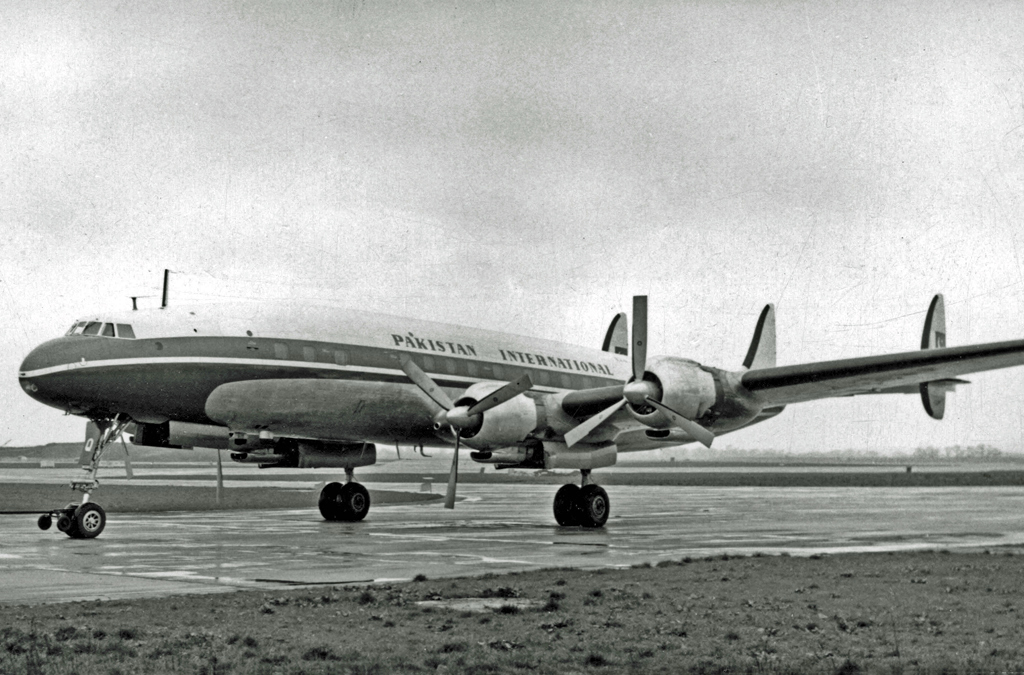While reading through six-decade-old issues of The Lockheed Star, the fortnightly newspaper of the Lockheed Aircraft Corporation, for a research project, I came across an article that had nothing to do with my topic of research, but I found it intriguing and got distracted reading it. (This is an occupational hazard for historians.)
The article, which appeared on the front page of the February 4, 1954 issue, is about the official handover of the first Lockheed Super Constellation airliner to Pakistan International Airlines (PIA), the national airline of Pakistan. The handover ceremony took place at Lockheed Air Terminal (now Bob Hope Airport in Burbank, California). On hand to receive the Super Constellation—a sleek, attractive airliner produced by Lockheed at its Burbank factory—was Ambassador Syed Amjad Ali.

A Pakistan International Airlines Lockheed Super Constellation at London-Heathrow. (Source: RuthAS on Wikimedia Commons, CC BY 3.0.)
The Pakistani ambassador was greeted by the daughter of a Lockheed design engineer, attired in a Shirley Temple-esque stewardess (flight attendant) outfit. The Lockheed Star reported: “Six-and-one-half year-old Sharon Owen—who is exactly the same age as Pakistan, born on Aug. 14, 1947—was on hand to dramatize what a young country the dominion is.” (A picture of little Sharon shaking hands with the ambassador appears on the PIA history webpage.)
The article goes on to note that Pakistan International Airlines would start service around mid-April 1954.
In fact, at this point, Pakistan International Airlines did not exist just yet. The airline was officially established by the Pakistani government on January 10, 1955, eleven months after the handover of the first Super Constellation. On its establishment, PIA absorbed Orient Airways, a quasi-national private airline that had been founded in 1946.
National airlines played an important, if largely symbolic, role in nation-building for many countries that gained independence in the decade or two after World War II. As Jeffrey Engel notes in his book Cold War at 30,000 Feet (2007):
It is little exaggeration to say that countries established during this period [the early Cold War] required three things before they could claim true sovereignty: an army, a flag, and an airline.
Pakistan certainly needed to prove itself in the early years after independence. A nation in two parts, with the enemy India in between, Pakistan looked to its new national airline as a way to link the two wings of the country and promote connections with friendly nations in the West. PIA’s first international destination was London, by way of Cairo and Rome. The Lockheed Constellations, of course, were from the United States—a country that also began supporting the Pakistani armed forces with large amounts of military aid at this time.
The Lockheed Star reported that the deputy general manager of PIA claimed that flexible seating arrangements in the Super Constellation cabin would allow the airline to offer low-cost coach class for the country’s masses. But air travel—international or domestic—remained out of the reach of the majority of Pakistani citizens. PIA was a luxury enjoyed by the prosperous, educated, English-speaking elite. The airline’s official name is “Pakistan International Airlines” in English. The logo is simply “P-I-A” spelled out in Perso-Arabic script.
By the way, just as Pakistan established an airline after independence, Bangladesh wasted no time in setting up its own national airline after seceding from Pakistan in 1971. Biman Bangladesh Airlines began operating less than three months after independence.
